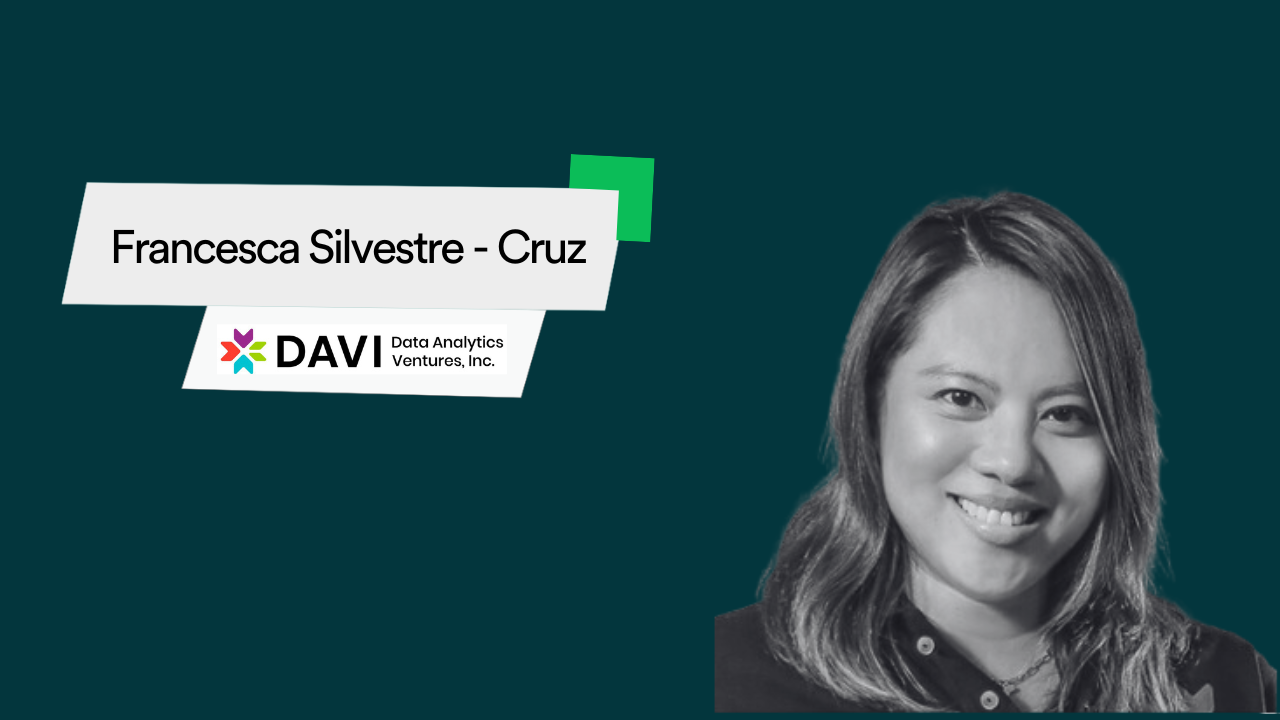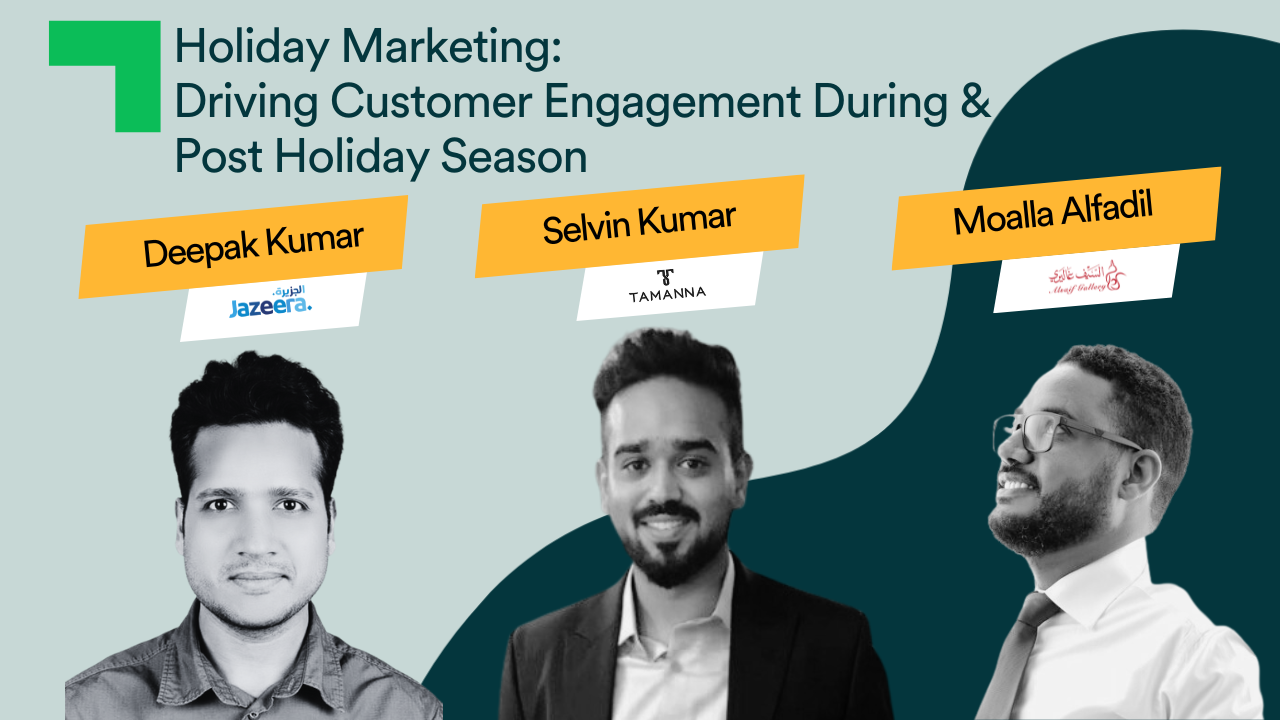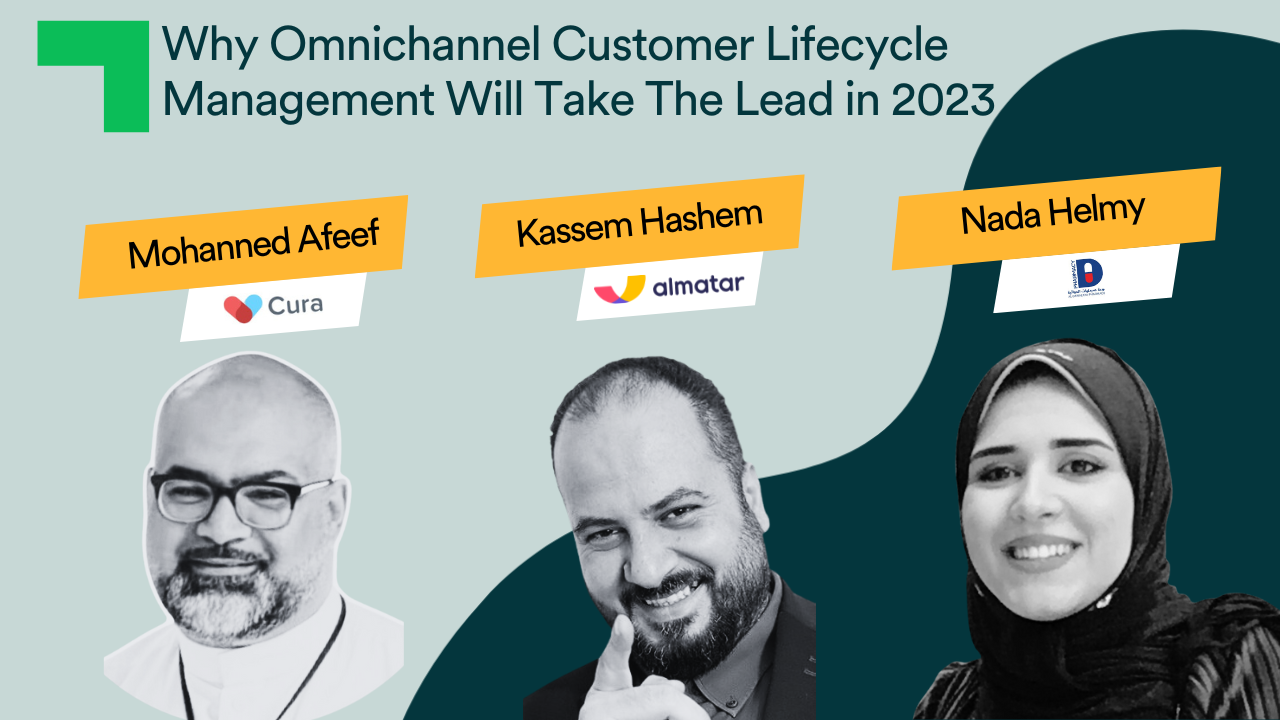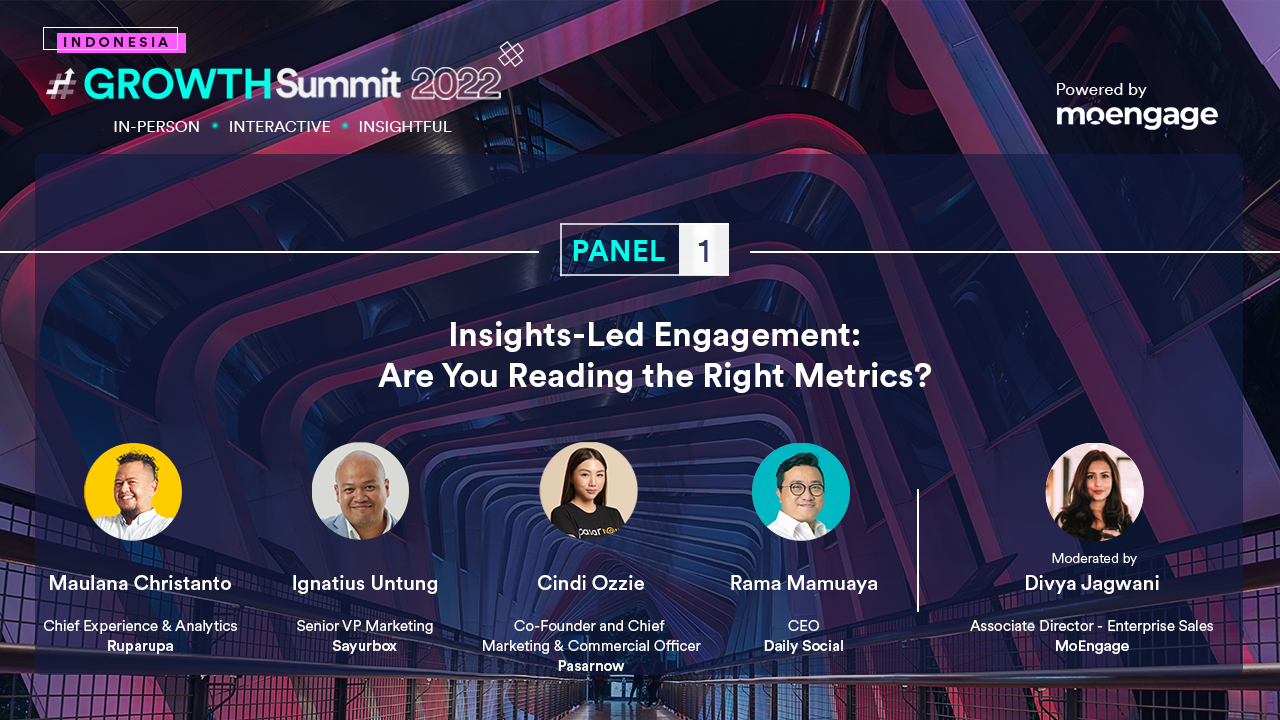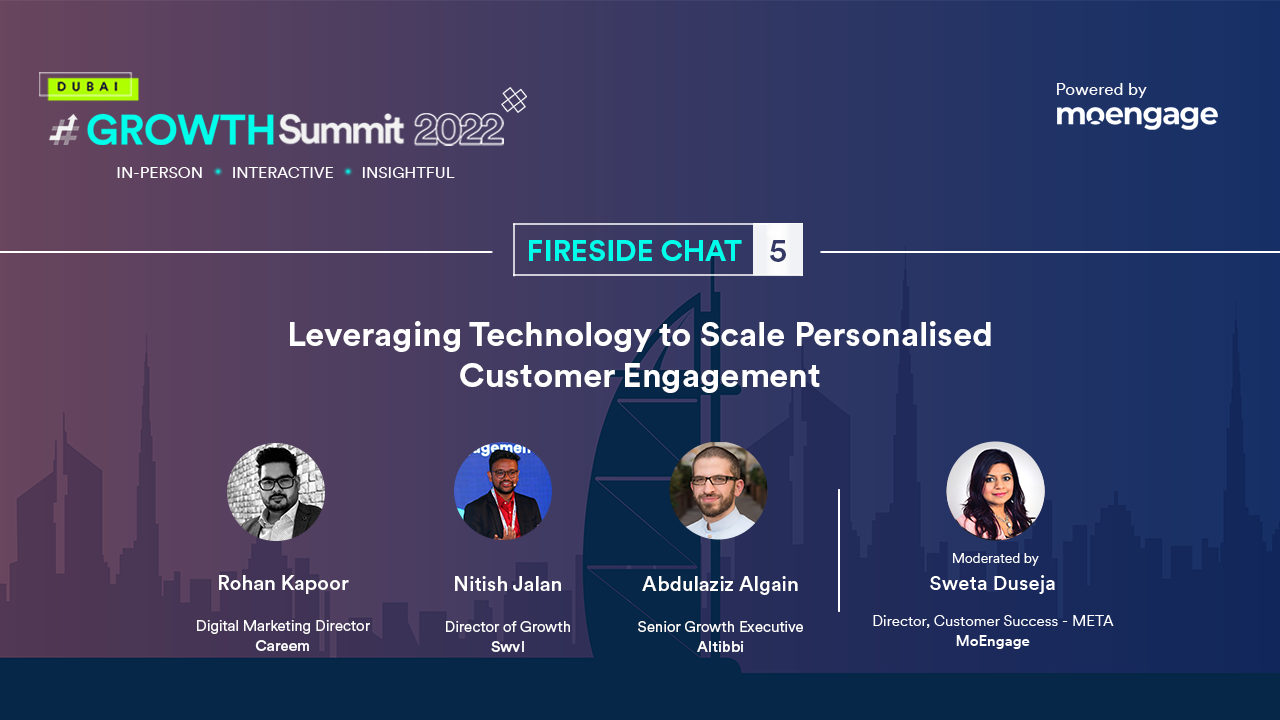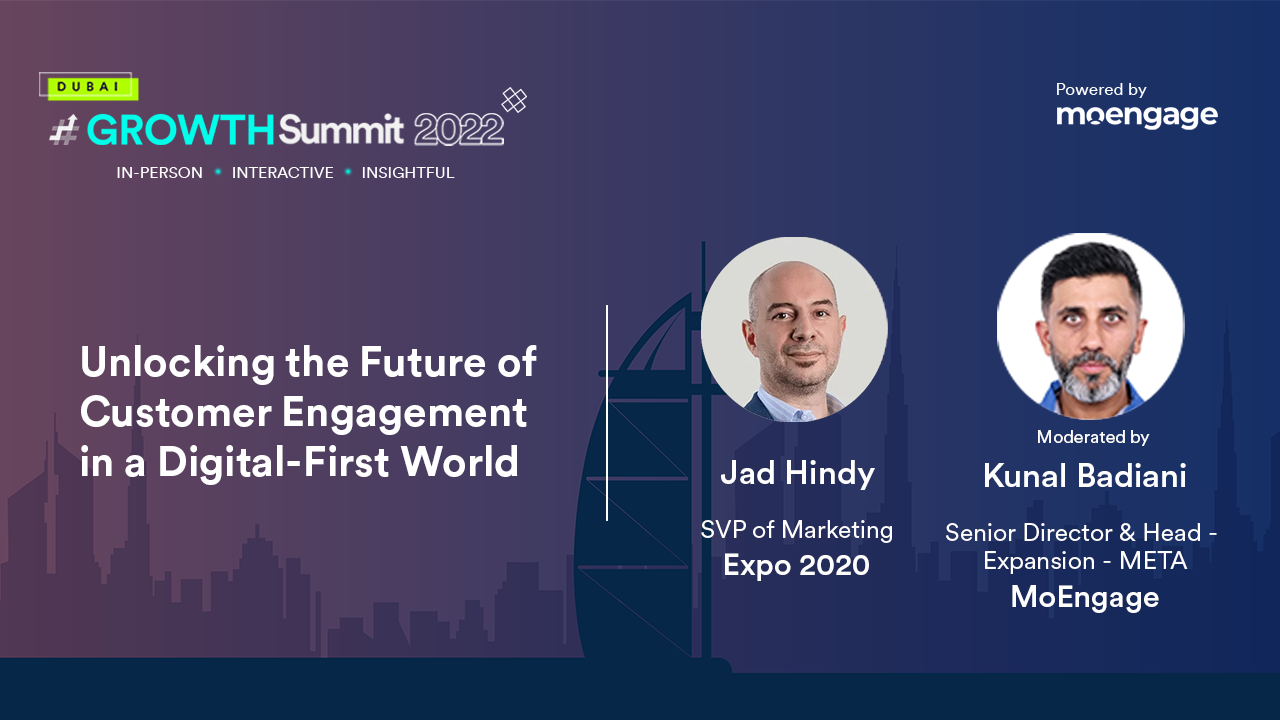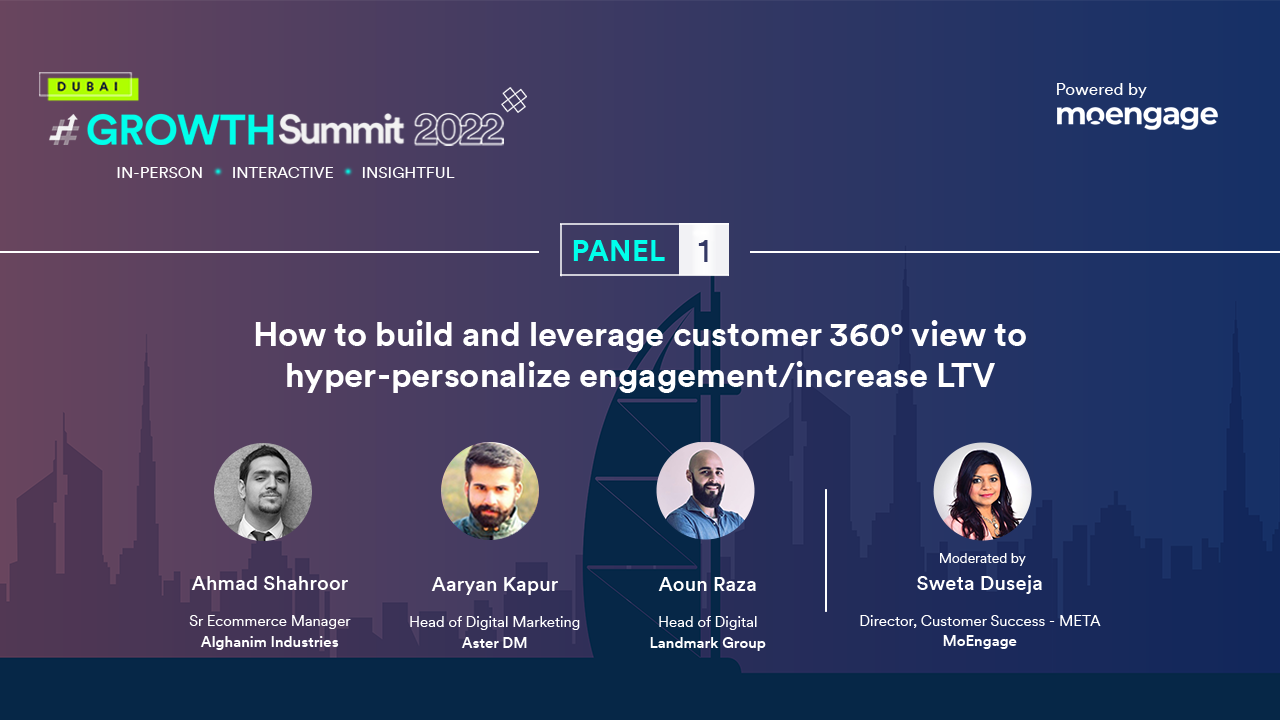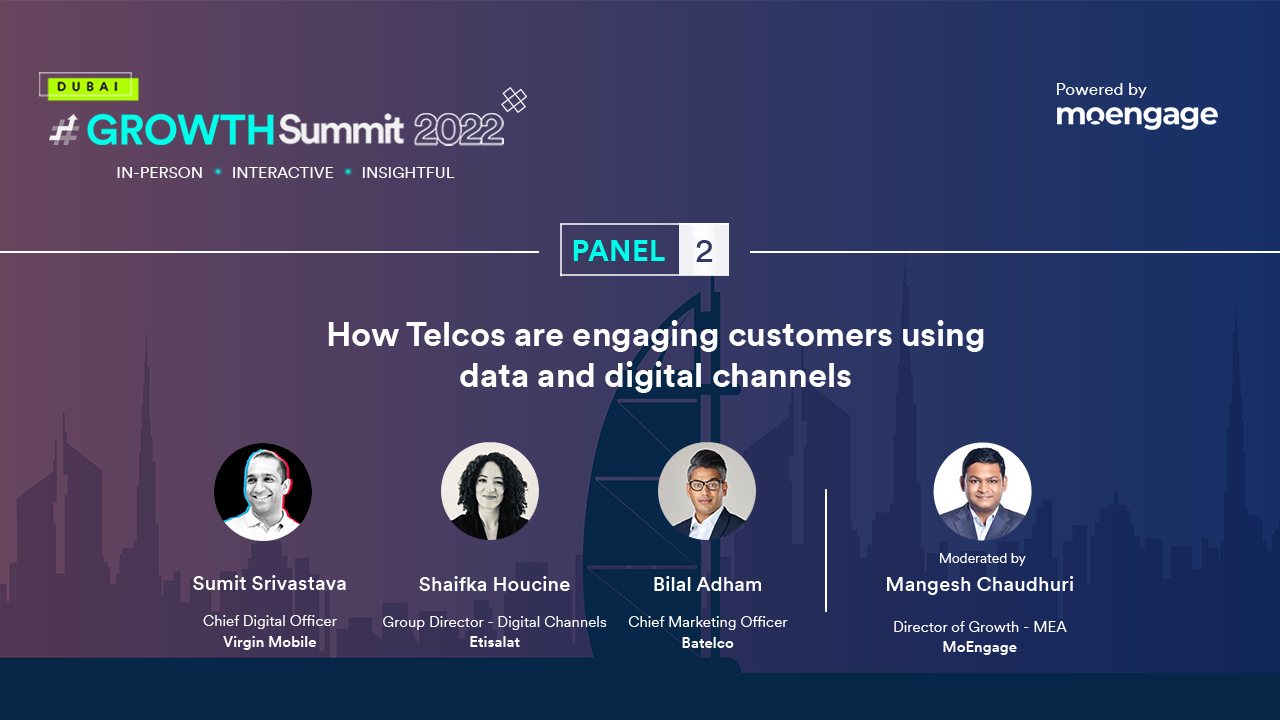Speaker – Francesca Silvestre Cruz, Growth Marketing Officer at Davi Data Analytics Venture
00:37 – How Davi Helps In Accelerating Growth In Business
Francesca Silvestre Cruz – So thank you so much for having me MoEngage. I can’t wait to get on board and work with MoEngage. So I’m Jessica Sylvester Cruz. I work with Davi. So we’re representing our team and so happy to be here today. It’s my first time to address such a big crowd, so lower your expectations.
I’ll make it fun. Prior to joining Davi in December last year, I founded a growth consulting company called CNA Consultancy Group where I remain a partner. Prior to that, I was in Unilever for 10 years and really upon joining Davi and being in an analytics company, I’m floored by what data driven marketing can do and how it can help accelerate growth for businesses.
So today, I’ll be sharing with you very practical and familiar use cases for data analytics. And I just have a short preamble to sort of set up the meat of the talk. So just bear with my three slides as a setup and then I’ll go right down to it. So, okay. I think many of you can relate how complex it is to get data and information together.
First about your customers, right, and even putting together reports for your business review. So prior to joining Davi, it actually takes us two hours to put together business performance reports because like if you’re in FMCG like you would get retail panel data from Nielsen, get consumer home panel data from cantar, and then you get your business analytics from whatever internal IT data infrastructure you have and then putting it together.
It’s very inefficient and to keep up in today’s fast paced VUCA world, you really need to speed things up and have data at your fingertips, right? So it’s very important to get platforms that sort of aggregate all of these make it seamless and it’s actually more cost efficient.
You don’t need to invest in building it. You can really just plug onto such platforms like MoEngage. So it’ll really make the lives of marketers better but also make your business operations business decisions and growth agenda much more effective.
3:26 – How Davi Overcomes The New Age Challenges
Francesca Silvestre Cruz – So we are in a very complex and evolving world, right? So first, experience trumps everything. In the pandemic everyone in the Philippines learned to shop online and now retailers, like offline retailers are struggling to get people back because after all, you can really just search for what you want, see all the assortment, read the reviews, and then how do you replicate that kind of experience in store? It’s hard, right?
So, and second, there is this competition for attention. So you’re not, you’re no longer just competing with other brands for advertising headspace, but you’re competing with Netflix, competing with videos that our consumers want to watch online. And lastly, aside from people skipping ads, people are also becoming more mindful about getting their personal information used by brands and companies.
So these are like challenges that we need to contend with and I’m so excited to share how we are doing it in Davi using Go Rewards.
4:52 – Marketing Cycle With Insights and Analytics
Francesca Silvestre Cruz – Okay. Last preamble slide. So this is the marketing cycle where you start with insights and analytics. In today’s day and age, data analytics are already available, AI already available, and I’ve seen very rich, or much richer data that comes out when you use machine learning and artificial intelligence.
So again, it’s time to really think about how you can get your business accessing such kinds of solutions. And then when it comes to consumer segmentation as well, it used to be very challenging. We relied on third party data, Cantar, Nielsen giving us information about our users.
So the key today is really getting access to first party data, building your own user base, and knowing them more so that you can communicate and target them more effectively. And then afterwards reach is another thing. So as mentioned earlier, paid ads are so expensive because you’re no longer just competing with the big brands but the internet or social media has democratized the playing field. You’re now competing with smaller merchants as well who are running Facebook, Instagram as well and lastly, a measurement of how you make, more robust business decisions about what to invest in, how to allocate your budgets, what to do more of and less of.
It’s so important to have this information at your fingertips. And having explored the MoEngage platform, I’m so happy that finally we’ll be able to do it right then and there in that one platform instead of having to ask our data analysts and data scientists to sort of extract it from our data hub before us marketers can actually learn from the data.
So there, so again, that’s just a short preamble of what also prompted me as a marketer to start working in the data analytics industry because I wanted to improve my skills and at the same time I wanted to be a more effective marketer.
So I joined Davi of the Gohan Way group, December of last year and I discovered how brands can drive growth by increase, growth and users engagement and value using loyalty. And you don’t need to own your own loyalty data. If you partner with companies like Davi for Go Rewards, you can actually have your own customer life cycle management program, and do precision marketing, which I’ll talk about.
So Go Rewards is a little bit of Intro to our loyalty program and it’s a happiness booster because every transaction of our members they can earn points and these points they can use to pay for goods and services. So we get transaction data, we are able to offer members personalized offers based on where they transact or where they shop and what they buy.
So they cross earn and use points in retail like Robinson’s retail stores. So if you go to the supermarket, At Robinson’s, please download our Go Rewards app. You can earn and use points also in Sabu Pacific. So for, you know, your travels, when you gas up in Caltech and even banks like Go time. So Go time, we’ll be launching soon. So Raymond was here earlier and really they will, they will triple your points and go. So again, it’s really about helping people, especially people that are struggling today, get more value for their money.
9:27 – Why Do Loyalty Programs Matter?
Francesca Silvestre Cruz – So why exactly do loyalty programs matter, especially for FMCG marketers and different businesses, and here are four reasons why. Number one, it’s vast and significant in size unlike if you want to learn from traditional research, agencies like using consumer panels. They only have thousands of respondents, whereas to represent the population, whereas Go rewards, we have 6.5 million members and are growing.
This was just 5.4 million last year. Number two, we use actual purchase behavior every day. Our database grows and we ingest 129 terabytes of data. So it’s dynamic. It’s constantly being mined to trap actual transactions of members over time, down to SKU’s purchase time of day and day of the week when they shopped.
Number three, it connects brands and businesses to the most valuable shoppers. Our members have 30% bigger basket sizes than non-member shoppers, and they actually contribute over 60% to total sales of our retail partners. And number four, it enables customized one-to-one marketing and this is much better than the social media targeting that is interest based because again, you already know people’s preferences based on what they actually buy.
10:59 – Engagment Through Loyalty Programs
Francesca Silvestre Cruz – Okay, so loyalty. Our loyalty program works in two ways, so we have a B2C business that has Go rewards, which I shared with you, and we have a B2B business. So by letting people earn points and by giving them customized offers, we are also learning more about their transactions and purchase behavior and this allows us to mind shopper analytics.
And we’re also able to do precision marketing which is good for brands, very efficient, and at the same time good for our members because they don’t get bombarded with different kinds of offers that are not relevant to them and as a result, we actually have 16 shopper personas in Davi because again our network of stores, merchants and partners span different industries.
So in social media, again such segments is akin to interest based targeting but since loyalty program use actual purchase behavior, targeting these shoppers and running campaigns with them result in actual sales and higher conversion rate. So just to give you like a few, you have the home providers, they actually constitute the biggest segment in our program.
But you can also hyper-target like feel good shoppers if you’re a business that would appeal to very indulgent people who like enjoying chips, chocolate, sweets, et cetera. And then if you’re in the health healthcare business you can target health. And then say, for Ed Mama, you can also target our parent teams or adults who are purchasing kids items in our stores at the same time, if you’re in the DIY and building business, you can target our home builders. If you’re in pet care, you can target their fur parents and so on.
13:08 – Different Types of Shoppers
Francesca Silvestre Cruz – Okay, so what I’m sharing with you is again supermarket pandemic-recovery shopper trends, and really, such research would typically cost like a brand or a company like millions to commission such, or even to access Nielsen’s shopper shopper chain support.
So we’re giving this today for free as a way of introducing Davi. So first thing we discovered from our loyalty, big data is and we tracked over 340,000 shoppers transactions with 120 million data points. So here we compared Q2 this year, 2022, when the market opened to Q1 2021 when the country was still on lockdown and starting to roll out vaccines.
So four Shopper pro profiles continue to evolve in 2022, and we segmented our member shoppers based on how much they spend and how much they consume or their basket sizes in terms of number of SKUs. So the first segment is thriving shoppers 34%. In Q2 2022 versus Q Q2 2021, they’ve actually been increasing their spend. They’re also increasing the quantity of items purchased. So even amidst inflation today, prices are going up, there is this segment now. The Filipinos in the room will relate hashtag Santa, that brands and businesses need to win with. Okay? So it’s very important to understand what products they’re actually buying so that you can angle, you can see how you can learn from this and win with such a segment.
Next is coping shoppers. So coping shoppers, their spend, this increasing but the volume, they’re actively managing their budgets and therefore their volume is decreasing in supermarkets. Next is the surviving shopper. So this is a very important segment because they’re almost half of the market. Surviving shoppers are spending less and also consuming less.
So smaller baskets and really brands and businesses today need to, like, we need to challenge ourselves to help them because they’re such a sizable segment and at the same time, if we help them like get access to our goods and services in today’s, you know, challenging. We think that we can build loyalty with them.
And then lastly, thrifty shoppers, they’re spending less but also buying more items per chip. So maybe these are shoppers that are downgrading from bigger pack sizes to smaller pack sizes, just so they can stretch their consumption. We’ve also been able to classify products based on how they’ve been moving in Q2 2022 versus Q2 2021.
So the green box represents indispensable or essentials, and basically they’ve, these are product categories that have maintained or even grew in terms of both volume and spend. The yellow box represents the flexibles or product categories whose volume had to be actively managed due to, um, increasing prices. And the red box represents constraining, or these are products that people are reducing in quantity and spending in the supermarket. And the next is, I’ll share how you know, the baskets off the two shop shopper segments, thriving shoppers and surviving shoppers look like presenting the different product categories.
So for thriving shoppers, these are people with stable jobs or maybe even, you know, increase their income during the pandemic. We’ve seen that they continue to maintain or even increase their spending in supermarkets and again, also increase their quantity per trip. So they actually consume even non-essential products such as cookies and juice and specifically you can see that they’ve been splurging on non-perishable food, like savory snacks or chips, seasonings and mixes and coffee. So I guess the question is for brands and businesses here, how can you win with these shoppers by maybe providing more delightful offerings, like if you’re in food, like more delightful flavors, more delightful formats.
18:20 – Surviving Shoppers
Francesca Silvestre Cruz – Okay, now the next for surviving shoppers. So again, they’ve been badly hit by the pandemic, maybe lost their job or maybe now just a single income household. I know a few personally and really they’ve reduced, again, they’ve reduced spending, reduced also their consumption for most supermarket product categories, especially savory snacks, instant noodles, and liquid milk.
Only breads make it, yeah, only breads there at the top left, uh, actually maintain, but in terms of spending, but the client volume, like all the rest. So how can brands help them maintain or even grow consumption? So I worked as a consultant before with McCormick Philippines, and, you know, McCormick, they sell spices and small glass bottles, right?
But those are quite expensive. So when they were seeing that, you know, consumption was going down and their prices were going up, they decided to sell these spices in packets or sas, but in multi-packs so that, you know, it was their way of helping the budget constraint shoppers to still afford buying their product, so maybe can explore more bite sized and affordable offerings for your business.
And what Davi can do to help brands and businesses also is do deep dives on specific product categories or consumption patterns. So for example, this is a case study for savory snacks, and if you purchase such data, you’re a savory snacks brand. Maybe you should look at what brand G is doing because Brand G, clearly, unlike the market trend, is growing in revenue, double digit, it’s stable quantity versus the rest that are declining really fast.
And then average spend is also increasing double digit and therefore, maybe like if you get access to such data for your category, learn from them and like look at what products they have, what flavors they have, and offer the same thing or something even better to win against, uh, to win amongst this shoppers first.
So next I’m going to talk about our core business which is actually customer lifecycle precision marketing and here we actually allow brands to do more effective marketing, and when we say more effective marketing, it’s because you can hyper target shoppers based on what they’re buying and offer and even customize your pro promotions and communications to make sure that you drive up conversions. So traditionally, like whenever we do promotions and for people here who are in supermarkets or in retail, we would have uniform mechanics open to all say when you put a discount or a bundle on the shelf, right?
And you target all of the shoppers who pass your category aisle. Now what precision marketing does is we actually enable brands to do objectives driven brand promo customized for different shopper segments and this enables more effective and efficient marketing. So to like give you a better case study for example, if you’re a Coca-Cola and you wish to run a precision marketing campaign with us, what we can help you do is actually segment all of our member shoppers.
So for your current brand buyers, your objective is to upsell. So maybe knowing each shopper’s average spend, you can, we actually introduce like 20% higher minimum spend to unlock an incentive or a promo for lapses or an infrequent buyers, you can actually reactivate them, like look at what they bought in the past.
Give an offer and talk about the benefits of that product to get them back into your brand. And then if you want to target competitor buyers then to make them switch or add coke to their basket, then maybe you can also communicate why you are better and offer a discount because it’s a business that you don’t have anyway, right?
So just get them into your brand if you believe in your product then go and promote it and then lastly, we can also target non-buyers of say, carbonated objects, but they buy associated categories like chips, so perfect with Coke or Jack Daniels for Jack Coke, right? And get them to add Coke to their basket.
So here we actually use AI. For market basket analysis to understand what are these associated categories that actually, um, have the same lift and association with the brand. And then again, we do one-to-one communications. So we reach our members through Viber with SMS fallback if they don’t have viber.
So Viber was discussed earlier. Our open rate is I think at 10 to 20%. So quite high for viber, unlike sms that can’t be measured. So we also do emails, but mostly we use viber and then we have a Go Rewards app. So again, please download the Go Rewards app when you shop in the marketplace. Shop Wise Robinson Supermarket, once you.
Are able to make transactions and we get that data. We give you very personalized offers and you can view this in your app. So turn it. So we learn that our members, upon arriving at the store, turn on their app. They look at the just for you section, for all the targeted offers to them.
So with precision marketing, we actually help brands and businesses sustain customer life cycles and grow customer lifetime value. So we again, So just a simple case study. So we segment existing brand buyers versus non-brand buyers, and then we can look at this different spend tiers or spend bands of current buyers and pack sizes that they buy, purchase frequency.
So we do like analytics even before running a campaign and then the goal when we target existing brand buyers to make sure that we grow the business of our partners incrementally, is to upsell them. So keep up selling them and then at the same time, we do target non-brand buyers to really grow the base of our brands, of our partners’ users.
Right? And we target labs, competitors are high propensity non buyers and once they’re on board, they slide now into the existing brand buyers, cycles or campaigns. So, we track this like how much your, what your current customer lifetime value is and then how we are helping you grow it over and customer life cycle precision marketing delivers real business impact. So we’re seeing revenue growth of up to 40 to 65%, 40% versus the same period last year, 65% versus pre-cycle. Our conversion rates before I joined Davi were only at 2.1% and average for all 2022 campaigns because of our constant IT and optimization is now up to 6.3%.
And in terms of penetration or number of buyers relative to the total member base, like our campaigns have been able to grow. Penetration by 1.2% for a brand and this is if you’re in, um, FMCG and you purchase like consumer panel data, you know how hard it is to move penetration. So again precision marketing works.
We also now purchase propensity models. We’ve been piloting this with our bank partners, so Union Bank for financial products and for FMCGs. So using machine learning and big data, you can discover the attributes of high potential users that brands can use to effectively recruit users and then even understand their path to purchase which I’ll talk about in the next slide.
27:51 – Case Study
Francesca Silvestre Cruz – So, case study. So we have an anti-dandruff shampoo brand partner and they wanted to recruit more users into the anti-dandruff category. So our purchase propensity model discovered that the high potential audience would typically be younger shoppers who are shopping frequently. They have higher spending on chocolate, coffee, and backyard perishables.
I don’t know if that causes the standard to go off and then higher. This is higher spend on beauty shampoo, baby shampoo and conditioner. It lowers the propensity. That’s why it’s at the bottom. So it simply means that, you know, the more specialized the shampoo products that the more specialized hair products that they buy, then the lower chances for them to actually buy any shampoo.
And this model has a 76.7% propensity score. We constantly, our, our data scientists look at different models to find the really high propensity one that we can activate in a campaign. We can also look at, path and learn from path to purchase conversion models. So this is an example for liquid laundry buyers.
So who here uses liquid laundry already? Okay, so really this is a low penetration or low usage category, and we recommend studying path to conversion models for categories like liquid laundry, liquid soap. So basically, once you know the path to purchase, like what products these shoppers were buying related or substitute products to liquid laundry prior to the switch, to the first time that they converted to liquid laundry, you can probably find these prime shoppers that again, have a higher propensity to convert to liquid laundry or to your brand, and you can also sort of recreate the conditions meaning get them to start buying this basket, a certain basket of good so that the logical next step, of course, with marketing comes intervention and offers is to now buy the product that you’re promoting. In this case, liquid laundry. You know just a short anecdote here. Also, I used to work in the deodorant category in Unilever, so handling re accent dove.
And it took us years to crack repeatable market development models and get people to start new habits like using a deodorant after taking a bath. But with machine learning, with AI and with big data such as these, Propensity models that we have, we’ve been able to, you know, shortcut this for the different brand partners that we work with.
So again, if you’re interested, we’d love to work with you and help you out. So that’s it. Uh, thank you so much for listening. I hope you picked up something and again, thank you so much to MoEngage for inviting Davi, and we wish everyone all the best, so take care.
Yeah. So, quick question. Do we have trends on switching from e-commerce to brick and mortar purchasing? Yeah, not yet. That would be great. Yeah. Not yet, but yes, that would be great. We have things in the pipeline that would probably give us that maybe next year.
Okay. Thank you Francesca for joining us on stage. Thank you. Really appreciate you coming on board.
